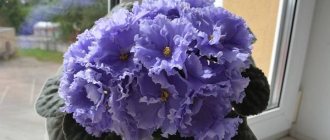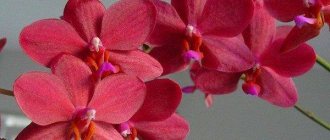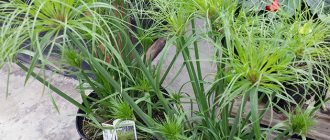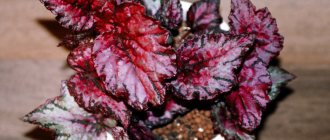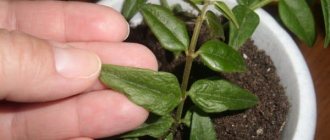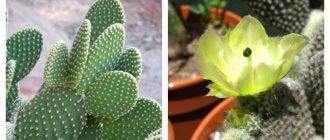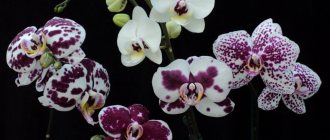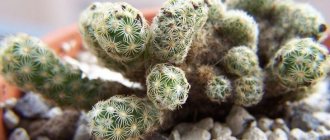Phalaenopsis Charmer belongs to the genus of hybrid phalaenopsis. This orchid itself is a separate species and has no varietal varieties. It differs from other phalaenopsis in the unusual contrasting color of its flowers, for which it received its name Charmer, which translated from English means “Sorcerer”.
Detailed description and photo
Phalaenopsis Charmer has yellow flowers that can reach a diameter of 8 cm , with burgundy-red splashes. These inclusions, their color, size and intensity largely depend on the conditions in which the orchid grows.
With proper care, the number of peduncles reaches four arrows, and their height is approximately 60 cm. They branch quite well.
The leaves of this species have an elongated oval shape and a dark green color. They themselves are fleshy and glossy, and their number varies from 3 to 8 pieces. The length of the leaf plates can reach up to 30 cm, and the width - up to 15 cm.
See photos of Phalaenopsis Charmer:
The root thickness is approximately 3-5 mm. The root system is no different from most orchids : fleshy and hollow roots.
Equestris (Phalaenopsis equestris - ichneumon ichneumon)
Distinctive features and external characteristics
Phalaenopsis equestris differs from most orchids of its species in having a rather short stem and succulent leaves capable of accumulating moisture.
It belongs to miniature forms due to its compactness and small peduncles. The arrows of the peduncles, although not high, are very branched.
The roots are aerial, flattened in most species, with a fairly thick layer of velamen. Due to the high presence of chlorophyll in their composition, some of the Equetris species have greenish roots.
The leaves of the plant can be oval or oblong. Their length usually does not exceed 15 cm and their width is about 6 cm.
The leaf structure is quite fleshy, with a thickness of about 2 mm. Color – dark green on the outside. The inner side of the leaf in some species may have a reddish tint.
There are usually several dark purple, branching peduncles. The height of different species can vary from 12 to 30 cm.
Multiple flowers are quite small in size - 15-30 mm (rarely found up to 50 mm) in diameter and round in shape. Short peduncles bear about 15 flowers.
Story
Its first description was dated in 1843 by Schauer. They were given the first name - Stauroglottis equestris. The original of these phalaenopsis was located on the island of Luzon with Mr. Meyen.
The name has changed several times. So in 1848, in the collection of one of his employees, John Lindley, this species was described as Phalaenopsis rosea, and only in 1849 it received its last name, which has survived to this day. Where this name came from is unknown.
Important! The large group of “Equestris”, in addition to the breeding name, has a trade name. Therefore, confusion often occurs when purchasing one type or another.
Native to the Philippines, Taiwan and Borneo.
Available colors
The color of the flowers varies greatly. Their colors range from white/white-pink to lilac colors and shades. The lip is slightly darker than the base color and has no whiskers.
The color of Equestris flowers can range from white to lilac.
Flowering: features, duration and dormancy
There are two distinct peaks of flowering - autumn and spring. But the sequential opening of flowers and the gradual growth of the peduncle during this period, on which new buds appear, significantly increases the duration of flowering. And since there are several flower stalks, this species can bloom for several months.
And although, according to sources, the peak of flowering occurs in the spring and autumn seasons, according to flower growers, it blooms in any season in optimal home conditions. Therefore, it also does not have a pronounced period of rest.
Subspecies
Alba (Phalaenopsis equestris var alba)
A miniature plant with narrow leaves and white, small flowers, about 2.8 cm. The yellow lip with splashes of color stands out especially against the white background.
Flowering is cluster and long lasting. There is an option with a pure white lip.
Phalaenopsis Equestris (photo of subspecies Alba).
This video features Phalaenopsis Equestris Alba:
Blue (Phalaenopsis equestris var. Coerulea (syn. Blue Lip))
Up to 25 cm phalaenopsis with numerous flowers having a lilac color with a blue tint.
Some gardeners boast of its flowering for up to 10 months.
Equestris var. Coerulea (syn. Blue Lip).
Gras (phalaenopsis equestris graz)
Some gardeners find it similar to Phalaenopsis Patricia Lillian. There is no mistake - this is how it is. Graz is the trade name of the orchid.
Beautiful, small, round-shaped flowers of lilac color. The number and duration of flowering is mesmerizing.
Graz, aka Phalaenopsis Patricia Lillian.
There are still a few varieties of equestris and there are often species in which the flowers transform into pelorics. This makes them even more unusual and attractive. Many photographs of Equestris can be found on the forum here.
How is it different from other orchids?
The characteristic and probably the most important difference between Charmer orchids is their color and color. As mentioned earlier, the flower of this plant has a yellow color with red-burgundy splashes , which become less intense and rare from the center to the periphery of the flower.
If we talk about the differences of this species that are imperceptible at first glance, it is necessary to mention that the flower does not have a specific dormant period, so it can develop all year round. The flowers bloom in turn, starting with those lower on the peduncle.
Since the Charmer orchid itself is a separate species, it has no varieties . No varieties have been released yet. But Charmer as a species belongs to the genus Phalaenopsis, which is represented by many interesting species:
“Big Lip”
This species is distinguished by an unfolded, large middle petal; it is not for nothing that the name of the species is translated as “big lip.”
"Golden"
A distinctive feature of this species is the color of the flower. Varieties belonging to it have yellow (from lemon to gold) flowers.
“Red Lips”
The middle of the flower of such a plant resembles the shape of lips and is colored red or a color close to it . The petals of the flower are white.
"Nice"
It is distinguished by oblong leaves and a long peduncle. The flowers are shaped like butterflies and are white in color.
"Schiller"
The leaves of this orchid have silver stripes and are colored red inside.
"Giant"
From the name it is clear that this plant is distinguished by its size, but it is not the flowers that are gigantic, but the leaves .
“Deer-horned”
This name was given because of the unusual structure of the peduncle, reminiscent of deer antlers. This plant has many thin and long leaves.
Only the most prominent representatives of this genus are listed here; in fact, there are many more of them; intergeneric hybrids also exist.
Falstaff
Features of the hybrid, external characteristics, possible colors
Quite a rare hybrid phalaenopsis. At least, there is practically no information about him in available sources.
Extraordinarily beautiful red/burgundy flowers with a white center and darker lip. The shape of the flowers is typical for this type of orchid, but the side petals are very noticeable. They are quite large in size. The flower itself can reach a size of 9-10 cm in diameter.
The root system and leaves are not very different from the standard ones and have average values.
According to the experience of gardeners, Phalaenopsis Falstaff gains color 2 times a year on fairly high peduncles, the number of which is from 1 to 3, with a height of 50 to 70 cm.
The coloring is difficult to confuse with other hybrids. Only the color intensity can change, which directly depends on the growing and care conditions.
Story
The seed parent is Phalaenopsis Millinova. The pollen parent is Phalaenopsis Sallie Bose. Registered H.Wallbrunn 07/12/1996
Flowering: features, duration and dormancy
Inflorescences with bilateral symmetrical flowers open sequentially, starting with the lowest flower.
Flowering duration is 8-15 weeks. It can bloom at any time of the year, with a very short rest period.
Falstaff.
How much does an adult Phalaenopsis Charmer cost in the store? Where can I buy it?
The price of an adult plant ranges from 1200 rubles to 2000.
The cost depends on the condition of the plant and the pricing policy of the store.
Adult plants are sold in special online stores, in stores with goods for the garden and vegetable garden, there are advertisements on websites for the sale of used things, rarely, but they can be found in hypermarkets.
Growing
The plant is a little capricious in care and living conditions. It is necessary to devote a sufficient amount of time to provide it with everything necessary. You need to start with the correct landing.
Landing
Planting a plant begins with the correct selection of soil. The optimal type of soil is a ready-made mixture intended for home planting. If you can’t find one, you can prepare it yourself:
- charcoal;
- components of inert origin (foam plastic, perlite, etc.);
- steamed pine bark;
Inaccurate composition of ingredients can harm the root system.
Planting container
Plant the orchid in plastic containers after washing them. The pot should have a large number of holes that will allow air to pass through.
It is better to take the container transparent, so the sun’s rays will fully warm up the root system even in the depths of the pot. The size should be adjusted to the volume of the root, but slightly larger than it, by 2-3 cm.
Growing by seeds
Planting a plant using seeds is a labor-intensive process. After the seeds have sunk into the ground, the container is tightly closed. The first shoots appear 9 – 10 months after planting. After 2 years, the plant is transplanted into a permanent pot.
Rostcom
Phalaenopsis orchids cannot be propagated by plucking the rhizomes. For this species it is necessary to use propagation using new shoots. The separated bulb should have 3 leaves and a root length of at least 4 cm. The shoot is placed in a special plastic pot and normal plant care begins.
Landing
The first thing you need to take care of is where to plant the flower, i.e. about the potty. When choosing it, do not forget that for the roots to participate in photosynthesis, you need a transparent pot with holes for drainage. The size of the pot should be a couple of centimeters larger than the root part.
The substrate can be purchased in stores designated for this purpose. If we talk about the composition of the soil, it usually contains:
- steamed tree bark;
- charcoal;
- sphagnum moss;
- various inert components.
How to plant correctly:
- Place drainage on the bottom of the pot in a layer of about 1-2 cm.
- Carefully remove the seedling from the container in which it is located. If there are rotten or damaged roots, cut them off and treat the cut area with cinnamon or charcoal powder.
- Spread the roots in a prepared pot with drainage.
- For plant stability, fill the interroot spaces with bark and moss with slight compaction.
External description of the flower
Phalaenopsis Equestris, from lat. Phalaenopsis equestris is a herbaceous plant of the Orchidaceae family. This is a hybrid species for home keeping.
Equestris is a miniature tree with small flower stalks. The stem is short and branched, the leaves are succulent, thanks to which moisture is easily collected and absorbed.
The root system is airy and compact. Has a thick layer of velamen. The roots contain chlorophyll, so some parts of them are green.
Leaves and flower stalks
Leaves are oval or oblong. Length no more than 16 cm, width up to 7 cm and thickness no more than 3 mm. The structure is dense, slightly meaty. On the outside they have a dark green color, on the inside the leaf is reddish.
The plant produces several flower stalks, dark purple in color. The height of each varies from 13 to 32 cm. There are up to 15 pieces on the peduncle. small flowers. Each of them has a diameter of 18–35 mm and a round shape.
The plant has a large palette of colors. Colors range from white, light pink to dark lilac. The plant's lip is barbelless and several shades darker than the base color.
How does a plant bloom?
There are two main flowering periods - spring and autumn. During these periods, the plant consistently produces several flower stalks. They gradually grow and produce new buds. This process significantly increases the duration of flowering. Therefore, Phalaenopsis equestris blooms for months.
This species is capable of blooming at any other time. Proper care and comfortable living conditions will have a beneficial effect on the general condition.
Caring for a plant at home
As for care, the environment is very important for this orchid ; its flowering directly depends on it. The determining factors in this case are temperature, lighting, air humidity and watering:
- The temperature during the day should be maintained within 22°-24°C, at night – 16°-18°C.
- Comfortable air humidity is approximately 40-60%.
- Leaves should not be exposed to direct sunlight, and the light should be diffused.
- It is better to use melt or rain water, as it is softer in structure. You need to water the plant when the walls of the pot become dry.
- Fertilizing can only be done with special fertilizer “For orchids” with every 3-4 waterings.
- During flowering, care generally does not change, but the plant needs additional nutrition.
- Trimming the peduncle after flowering is very simple. It is enough just to identify the dried part of the peduncle, cut it off and then treat the cut with activated carbon or cinnamon.
- Sometimes the plant does not bloom for a long time, to eliminate this problem, make sure that it is properly cared for and maintained. This is the first and main reason.
- To renew flowering, an effective method is to imitate the rainy season. First, you should place the pot with the roots in warm water for three days, and then leave it without watering for 2 weeks.
- Replanting a plant is carried out according to the same algorithm as planting it.
Features of care
The Charmer orchid grows well in a room, provided the right location is chosen, the temperature and humidity are suitable, with proper watering and fertilizing, and protection from infection and pests.
Conditions of detention
It is better to place the pot on the eastern or western windowsill. It is undesirable for the flower to be exposed to direct midday rays of the sun, otherwise a burn may form on the leaves.
If the apartment has only southern windows, the orchid is placed not on the windowsill, but on a stand near the window covered with curtains.
To prevent the flower from bending towards the light, it must be turned once every 2 to 3 weeks.
The optimal room temperature is 15-25°C. However, phalaenopsis easily tolerates a short decrease in temperature to 12°C and an increase to 35°C.
Humidity should be moderate - 30-40% and good ventilation.
Watering
Water the orchid after the soil dries. But the substrate should not be allowed to remain dry for a long time.
A transparent pot is convenient because it allows you to determine the need for watering: moistening is carried out when condensation disappears from the inner walls of the container and the roots turn pale.
Overwatering is unacceptable: the growing point will rot and the plant will die.
If the container is opaque, you will have to dig up the soil to check how dry the layer inside is.
Water is poured either from above onto the ground, avoiding contact with the leaves, or bottom watering is used, lowering the pot into a basin of water so that the roots draw the required amount of moisture through the drainage holes.
Take soft, settled, clean water. Once a month, it is advisable to spray the flower or rinse the leaves under running water.
Feeding
Fertilizers improve flowering
Suitable fertilizer is the key to full development and lush flowering.
Nutrients are absorbed by the roots, so fertilizing is carried out with liquid (water-soluble) preparations. The best option is Kemira-Lux. For phalaenopsis, reduce the dosage by half.
An orchid needs nitrogen to grow foliage. But you shouldn’t overdo it with this substance, otherwise the flower will actively produce leaves rather than peduncles.
If a flowering shoot does not appear for a long time, this is a signal that there is not enough potassium and phosphorus.
Prevention of various problems
The main preventive measure is proper care of the plant and the creation of suitable conditions. also considered effective, but it is important to avoid excess fertilizer .
The Charmer orchid, although it is an unpretentious representative of phalaenopsis, if basic maintenance conditions are not met, it can be affected by parasites and various diseases, and may stop blooming. But if you take a responsible approach to caring for it and create comfortable conditions for it, it will delight you with its “sunny” inflorescences for many years.
Prevention of diseases and pests
Phalaenopsis has a fairly strong immune system. Infectious diseases appear only with improper care.
In rare cases, increased air humidity contributes to the spread of pests. They are usually brought into the house with an already infected plant.
When purchasing, it is important to carefully examine the orchid for signs of insect damage.
Infectious pathologies are possible:
- fusarium;
- anthracnose;
- different types of rot;
- powdery mildew;
- viral infections.
Of the insects that can attack an orchid:
- mites;
- whitefly;
- aphid;
- woodlice;
- thrips;
- mealybug;
- thyroid gland;
- springtail.
Prevention measures
- Do not allow the soil to become waterlogged. Use soft, lukewarm water for irrigation.
- Protect the flower from prolonged heat and direct sun.
- Control the temperature in the room.
- Fertilizers are applied in the optimal dosage.
- The roots are periodically treated with anti-pest drugs in a prophylactic dose.
- To strengthen the immune system, Fitosporin and vitamin herbal preparations are used.
- Wipe the leaves with a damp cloth.
Other types
You can find other types of orchids in garden centers. For example, this is Angrekum Leonis, which has a peculiar but pleasant smell, as well as sickle-shaped leaves. On the peduncle, no more than three very large flowers with waxy white petals are formed (less often they are ivory-colored).
Flower growers also love zygopetalum - this is a rather rare type of orchid, but extremely beautiful because it is distinguished by its graceful petal shape and unusual color. Beginners are often afraid to purchase zygopetalums, thinking that such an unusual species requires some special, labor-intensive care. But in fact, this is just a common misconception. Caring for zygopetalum differs little from other types of orchids that form pseudobulbs. At the same time, it looks very impressive thanks to petals with various colors and patterns of spots and inclusions. Zygopetalum blooms mainly during the winter months. On one peduncle, from 10 to 20 buds are formed, which then open into medium-sized flowers, emitting a delicate sweetish aroma.
Catasetum is another original variety of orchid. A distinctive feature is the ability to simultaneously form flowers that differ in size and color. And all because both male and female, and even bisexual flowers bloom on one plant. At the same time, they look very decorative.
Cattleya can hardly be called exotic; it is a very common species, which includes varieties with both large and small flowers. In garden centers, Cattleya is represented mainly by hybrids. They can be white, pink, lilac, beige in color.
A very beautiful type of orchid is the dendrobium. It is distinguished by decorative cylindrical leaves and spectacular flowers, the diameter of which can reach 6-8 cm. They are collected several at a time into inflorescences formed on long peduncles. Among the varieties of dendrobium, two-color varieties are especially popular. Dendrobium blooms twice a year, in winter and summer. Depending on the specific variety, the color of the flowers can be pink, beige, or purple.
Cambria is a decorative flowering hybrid. It was obtained by crossing several species of orchids. Its main advantage is the varied colors of the flowers.
It is quite difficult to recognize it among other similar species if you do not pay attention to the flowers themselves - this plant does not look like a butterfly, its flowers are star-shaped. In addition, Cambria is characterized by a shoot type of growth.
Its leaves are narrow and elongated, and have a dark green color. Up to 10 quite large flowers are formed on one peduncle. The disadvantage of this type of orchid is that it is a rather capricious plant, requiring constant maintenance of temperature and light conditions, as well as a certain level of humidity.
Another capricious plant is celogina. It is quite rarely grown at home, since celogina is demanding. But it blooms with very beautiful and fragrant snow-white flowers. It blooms profusely (at least 10 buds are formed on one peduncle), and its flowering period is long - up to three months, so all efforts to grow will not be in vain.
Macodes looks very nice. This plant is distinguished by decorative foliage, which is quite rare for an orchid. And in this case, it has not only a spectacular color with streaks of golden, silver or copper shades, but also a surface that is velvety to the touch. Its leaves themselves come in different shades - from light green to cherry and even amber-black. True, makodes are just as capricious as the species listed above, even if their beauty compensates for all the troubles associated with them.
What species are royal orchids? In fact, such a plant is unlikely to be found in botanical classifiers. Large varieties of phalaenopsis are called royal. However, some varieties of the Vanda orchid also have this name. So it’s hardly possible to talk about any specific species here. In addition, any orchids themselves are so beautiful that they can safely be called royal.

